Monocrystalline Solar Panels
This is the oldest and most developed of the three technologies. Monocrystalline panels as the name suggests are created from a single continuous crystal structure. A Monocrystalline panel can be identified from the solar cells which all appear as a single flat colour. They are made through the Czochralski method where a silicon crystal ‘seed’ is placed in a vat of molten silicon. The seed is then slowly drawn up with the molten silicon forming a solid crystal structure around the seed known as an ingot. The ingot of solid crystal silicon that is formed is then finely sliced ingot what is known as a silicon wafer. This is then made into a cell. The Czochralski process results in large cylindrical ingots. Four sides are cut out of the ingots to make silicon wafers. A significant amount of the original silicon ends up as waste.
Advantages
- Mono panels are the most efficient since they’re made with high-quality silicon. They typically perform better than polycrystalline alternatives, albeit by a small amount.
- Because of their quality, they also tend to last the longest. Many installers offer a warranty of at least 25 years, with most panels poised to last beyond that.
- Mono solar panels make the most energy for space they take up, thanks to their high efficiency.
Disadvantages
- Since they’re the highest-quality, they’re the most expensive.
- Due to the way mono panels are wired, covering one section can lead to the panel not working properly. This can be something as simple as a tree’s shade or snow landing on the panel, but there are wiring options to avoid this issue.
- If you’re concerned about waste as well as energy, a mono solar panel, unfortunately, creates more silicon waste than other types of panels.
Polycrystalline Solar Panels
Polycrystalline is also about 20% cheaper to produce and creates less waste silicon in the process. If you’re looking for the lowest price, polycrystalline panels are probably your best bet. However, polycrystalline experiences internal efficiency losses due to the structural inconsistency at the seams where two different crystals meet; due to the lower purity of the silicon. Polycrystalline panels have about 13 to 16% efficiency, while monocrystalline panels have an efficiency rate of anywhere from 15 to 20%. You would need a much larger array of polycrystalline panels to produce the same amount of energy than if you used monocrystalline, which may not work for households with limited roof space.
Advantages
- The process used to make polycrystalline silicon is simpler and cost less. The amount of waste silicon is less compared to monocrystalline.
- Polycrystalline solar panels tend to have slightly lower heat tolerance than monocrystalline solar panels. Polycrystalline solar panels will tend to have a higher temperature coefficient than solar modules made with mono cells. This means that as heat increased output for this type of cell will fall less. However, in practice, these differences are very minor.
Disadvantages
- The efficiency of polycrystalline-based solar panels is typically 14-16%. Because of lower silicon purity, polycrystalline solar panels are not quite as efficient as monocrystalline solar panels.
- Lower space-efficiency. You generally need to cover a larger surface to output the same electrical power as you would with a solar panel made of monocrystalline silicon. However, this does not mean every monocrystalline solar panel perform better than those based on polycrystalline silicon.
- Monocrystalline and thin-film solar panels tend to be more aesthetically pleasing since they have a more uniform look compared to the speckled blue color of polycrystalline silicon.
For more details: Soura Natural Energy Solutions



Great article.Solar Panel CT is proud to offer our customers the most affordable and reliable solar panels available today. Our products are built to last and backed by an industry leading warranty. We have been selling solar energy systems since 2008 and we know what it takes to provide quality customer service and support.
ReplyDelete